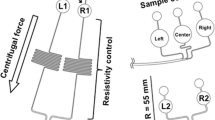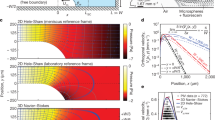Abstract
In this paper, we implement rotational flow control on a polymeric microfluidic “lab-on-a-disc” platform by combining serial siphoning and capillary valving for sequential release of a set of on-board stored liquid reagents into a common (assay) channel. The functionality of this integrated, multi-step, multi-reagent centrifugal assay platform critically depends on the capability to establish very reproducible, capillary-driven priming of the innately only weakly hydrophilic siphon microchannels made from common poly(methyl methacrylate) (PMMA) substrates. Due to the relatively high contact angle of the native PMMA substrate, it was practically impossible to ensure sequential release of on-board stored reagents using the capillary-driven serial siphon valves. In this work, we demonstrate that spin-coated hydrophilic films of poly(vinyl alcohol) (PVA) and (hydroxypropyl)methyl cellulose (HPMC) provide stable contact angles on PMMA substrates for more than 60 days. The deposited films were characterized using contact angle measurements, surface energy calculations and X-ray photoelectron spectroscopy spectra. The PVA and HPMC films reduced the water contact angle of the PMMA substrate from 68° to 22° and 27° while increasing their surface energies from 47 to 62 and 57 mN m−1, respectively. On the centrifugal microfluidic platform, the films were validated to enable the effective and reproducible priming of the serial siphon microchannels at low rotational frequencies while ensuring that the in-line capillary valves are not opened until their respective burst frequencies are passed. Furthermore, the biocompatibility of the proposed surface modification method was examined, and the platform was used to run a sandwich immunoassay for the detection of human immunoglobulin G, and its performance was proven to be comparable to dynamic coating using surfactants.









Similar content being viewed by others
References
Bhattacharya A, Rawlins JW, Ray P (2008) Polymer grafting and crosslinking. Wiley, Hoboken
Carré A (2007) Polar interactions at liquid/polymer interfaces. J Adhes Sci Technol 21:961–981. doi:10.1163/156856107781393875
Coma V, Sebti I, Pardon P et al (2003) Film properties from crosslinking of cellulosic derivatives with a polyfunctional carboxylic acid. Carbohydr Polym 51:265–271. doi:10.1016/S0144-8617(02)00191-1
DeMerlis CC, Schoneker DR (2003) Review of the oral toxicity of polyvinyl alcohol (PVA). Food Chem Toxicol 41:319–326
Ducrée J, Haeberle S, Lutz S et al (2007) The centrifugal microfluidic bio-disk platform. J Micromech Microeng 17:S103–S115. doi:10.1088/0960-1317/17/7/S07
Grumann M, Brenner T, Beer C et al (2005) Visualization of flow patterning in high-speed centrifugal microfluidics. Rev Sci Instrum 76:025101. doi:10.1063/1.1834703
Gubala V, Gandhiraman RP, Volcke C et al (2010) Functionalization of cycloolefin polymer surfaces by plasma-enhanced chemical vapour deposition: comprehensive characterization and analysis of the contact surface and the bulk of aminosiloxane coatings. Analyst 135:1375–1381
Gubala V, Siegrist J, Monaghan R et al (2013) Analytica chimica acta simple approach to study biomolecule adsorption in polymeric microfluidic channels. Anal Chim Acta 760:75–82
Horvath J, Dolník V (2001) Polymer wall coatings for capillary electrophoresis. Electrophoresis 22:644–655. doi:10.1002/1522-2683(200102)22:4<644:AID-ELPS644>3.0.CO;2-3
Hozumi A, Masuda T, Hayashi K et al (2002) Spatially defined surface modification of poly(methyl methacrylate) using 172 nm vacuum ultraviolet light. Langmuir 18:9022–9027
Kaelble DH (1970) Dispersion-polar surface tension properties of organic solids. J Adhesion 2:66–81
Kitsara M, Ducrée J (2013) Integration of functional materials and surface modification for polymeric microfluidic systems. J Micromech Microeng 23:033001. doi:10.1088/0960-1317/23/3/033001
Krumova M, López D, Benavente R et al (2000) Effect of crosslinking on the mechanical and thermal properties of poly(vinyl alcohol). Polymer 41:9265–9272. doi:10.1016/S0032-3861(00)00287-1
Kurzbuch D, Bakker J, Melin J et al (2009) A biochip reader using super critical angle fluorescence. Sens Actuators B Chem 137:1–6. doi:10.1016/j.snb.2008.12.057
Kurzbuch D, Bakker JWP, Ruckstuhl T, Melin J (2010) Super critical angle fluorescence scanning system. U.P.T. Office (Ed.), United States
Louette P, Bodino F, Pireaux J–J (2005a) Poly(methyl methacrylate) (PMMA) XPS Reference Core Level and Energy Loss Spectra. Surf Sci Spectra 12:69. doi:10.1116/11.20050914
Louette P, Bodino F, Pireaux J–J (2005b) Poly(vinyl alcohol) (PVA) XPS reference core level and energy loss spectra. Surf Sci Spectra 12:106. doi:10.1116/11.20050922
Lucy CA, MacDonald AM, Gulcev MD (2008) Non-covalent capillary coatings for protein separations in capillary electrophoresis. J Chromatogr A 1184:81–105. doi:10.1016/j.chroma.2007.10.114
Machiste EO, Buckton G (1996) Dynamic surface tension studies of hydroxypropylmethylcellulose film-coating solutions. Int J Pharm 145:197–201
Matsunaga T, Ikada Y (1981) Dispersive component of surface free energy of hydrophilic polymers. J Colloid Interface Sci 84:8–13. doi:10.1016/0021-9797(81)90253-8
Nguyen T-P, Dupraz A (1997) Spectroscopic studies of a multiphasic polymer-ceramic mixture material. J Biomater Sci Polym Ed 8:141–149. doi:10.1163/156856296X00219
Nwankire CE, Dowling DP (2010) Influence of nm-thick atmospheric plasma deposited coatings on the adhesion of silicone elastomer to stainless steel. J Adhes Sci Technol 24:1291–1302. doi:10.1163/016942409X12561252292062
Nwankire CE, Donohoe GG, Zhang X et al (2013) At-line bioprocess monitoring by immunoassay with rotationally controlled serial siphoning and integrated supercritical angle fluorescence optics. Anal Chim Acta 781:54–62. doi:10.1016/j.aca.2013.04.016
Okada H, Kaji N, Tokeshi M, Baba Y (2007) Channel wall coating on a poly(methyl methacrylate) CE microchip by thermal immobilization of a cellulose derivative for size-based protein separation. Electrophoresis 28:4582–4589. doi:10.1002/elps.200700105
Owens DK, Wendt RC (1969) Estimation of the surface free energy of polymers. J Appl Polym Sci 13:1741–1747. doi:10.1592/phco.30.10.1004
Ozaydin-Ince G, Coclite AM, Gleason KK (2012) CVD of polymeric thin films: applications in sensors, biotechnology, microelectronics/organic electronics, microfluidics, MEMS, composites and membranes. Reports on Progress in Physics 75:016501 (p 40). doi:10.1088/0034-4885/75/1/016501
Pavli P, Petrou PS, Douvas AM et al (2011) Selective immobilization of proteins guided by photo-patterned poly(vinyl alcohol) structures. Procedia Eng 25:292–295. doi:10.1016/j.proeng.2011.12.072
Pérez OE, Sánchez CC, Pilosof AMR, Rodríguez Patino JM (2008) Dynamics of adsorption of hydroxypropyl methylcellulose at the air–water interface. Food Hydrocoll 22:387–402. doi:10.1016/j.foodhyd.2006.12.005
Peytavi R, Raymond FR, Gagné D et al (2005) Microfluidic device for rapid (<15 min) automated microarray hybridization. Clin Chem 51:1836–1844. doi:10.1373/clinchem.2005.052845
Riaz A, Gandhiraman RP, Dimov IK et al (2012) Reactive deposition of nano-films in deep polymeric microcavities. Lab Chip 12:4877–4883. doi:10.1039/c2lc40296c
Righetti PG, Gelfi C, Verzola B, Castelletti L (2001) The state of the art of dynamic coatings. Electrophoresis 22:603–611
Shah JJ, Geist J, Locascio LE et al (2006) Surface modification of poly(methyl methacrylate) for improved adsorption of wall coating polymers for microchip electrophoresis. Electrophoresis 27:3788–3796. doi:10.1002/elps.200600118
Siegrist J, Gorkin R, Clime L et al (2009) Serial siphon valving for centrifugal microfluidic platforms. Microfluid Nanofluid 9:55–63. doi:10.1007/s10404-009-0523-5
Siegrist J, Donohoe G, Somers M et al (2011) A centrifugo-microfluidic cartridge with integrated detection optics towards automated at-line bioprocess monitoring of immunoglobulin G. 15th International Conference on Miniaturized Systems for Chemistry and Life Sciences, pp 194–196
Steigert J, Brenner T, Grumann M et al (2007) Integrated siphon-based metering and sedimentation of whole blood on a hydrophilic lab-on-a-disk. Biomed Microdevices 9:675–679. doi:10.1007/s10544-007-9076-0
Strom GCRAN, Fredriksson M, Stenius PER (1987) Contact angles, work of adhesion, and interfacial tensions at a dissolving hydrocarbon surface. J Colloid Interface Sci 119:352–361
Ton-That C, Sharda G, Teare DOH, Bradley RH (2001) XPS and AFM surface studies of solvent-cast PS/PMMA blends. Polymer 42:1121–1129. doi:10.1016/S0032-3861(00)00448-1
Weikart CM, Yasuda HK (2000) Modification, degradation, and stability of polymeric surfaces treated with reactive plasmas. J Polym Sci, Part A: Polym Chem 38:3028–3042. doi:10.1002/1099-0518(20000901)38:17<3028:AID-POLA30>3.0.CO;2-B
Acknowledgments
This work has been supported partly by the FP-7 ENIAC programme CAJAL4EU, ERDF, Enterprise Ireland (Grant No. IR/2010/0002) and the Science Foundation of Ireland (Grant No. 10/CE/B1821). Authors would like to thank R. Monaghan for the PECVD APTES depositions.
Author information
Authors and Affiliations
Corresponding author
Rights and permissions
About this article
Cite this article
Kitsara, M., Nwankire, C.E., Walsh, L. et al. Spin coating of hydrophilic polymeric films for enhanced centrifugal flow control by serial siphoning. Microfluid Nanofluid 16, 691–699 (2014). https://doi.org/10.1007/s10404-013-1266-x
Received:
Accepted:
Published:
Issue Date:
DOI: https://doi.org/10.1007/s10404-013-1266-x




